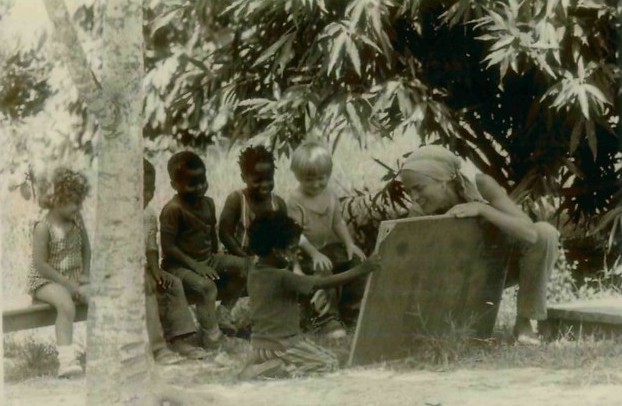(Edward Cromarty is a regular contributor to the jonestown report. His other article in this edition is Communal Learning in the Socialist Context of Jonestown. His complete collection of articles is here. He can be reached at edwardcromarty@hotmail.com.)
This project began as an exploration of the use of indigenous materials in the education programs of the Jonestown Project in Guyana. The research into the use of indigenous materials led to a deeper analysis of education in Jonestown than physical materials. It involved community learning, immersion education, and the desire of Guyanese socialist experimentation to achieve freedom from the postcolonial system which governed Guyanese education in the 1970’s. The use of educational materials natural to the region symbolized the struggle for the self-determination and equality of the people of Jonestown and Guyana.
Education in Guyana
In the 1970’s Guyana was a developing nation which had won its independence in 1966 and inherited a tradition of Christian education based on the British colonial system. To support the new nation’s economic and social development, it was necessary to convert its education system from an elitist colonial to a socialist educational system. This would require expansion of access for all Guyanese without discriminatory barriers and would include reforms such as compulsory education, teacher training, technological improvement, and development of the values to achieve freedom and equality (Ishmael, 2012).
In 1976 the colonial-based dual education system supported by the Christian churches and the conservative PNC was abolished, and a secular system supporting the socialist educational reforms favored by the cooperative socialist PPP was established. Severe shortages of teachers, teacher training, classroom space, and learning materials existed. There was the need for the social support services that allow impoverished students to attend school. Only 78% of children of primary school age attended classes, and 94% of secondary-school age students were denied free tuition, channeling them instead into employment, military, or unemployment. Admission to higher education and the technical institutes was granted to only 9% of students. Educational and social development required improved access to the sciences, agriculture, technology, vocational training, and Guyanese history in place of European colonial society. Bilingual Spanish-English language education was required to remove communication barriers to Latin American social and economic assistance. It was necessary to improve working conditions and give teachers control of textbook and curriculum design (Ishmael, 2012).
The school system played an important role in community and social health. In the 1970’s over 50% of pre-school children suffered from malnutrition, a rate which increased through the 1980’s. School feeding programs crucial to the well-being of primary school children which had been available in the 1960’s, offering nutritious snacks, milk, and cod liver oil pills, had been discontinued by the PNC, leading to rising rates of child malnutrition. Programs were needed to assure clean running water, toilet facilities, and safe hygienic classrooms. Basic education was deprived to large segments of the population, with a 20% absentee rate among primary students and 40% among secondary students. The basic need for food was the primary reason for absenteeism, as children were needed to assist parents on farms or to stand on food lines. Absenteeism led to delinquency, and delinquents too often became hardened criminals (Ishmael, 2012). School programs which had offered regular dental and medical check-ups had also been discontinued by the PNC, leading to declining health and living standards in the population. The development of Guyanese society was dependent on reformation of the school system to meet the educational and social needs of a nation which had recently achieved freedom from colonial repression.
The cooperative socialist Guyanese government liked the promise of equality offered by Jonestown, and promoted its establishment to provide medical, educational, and agricultural assistance to the rural northwest region of Guyana (Jonestown: A Model of Cooperation, 1978). This policy coordinated with attempts of newly-found postcolonial Caribbean governments to make education accessible (Brissett, 2018). Deep-rooted asymmetries of power, exploitation, and inequality resulting from colonization existed in education systems as part of the larger society.
Amerindian Education in Guyana
The majority indigenous Amerindian population in the inner regions were among the most neglected of Guyana’s rural communities. School buildings were in serious disrepair or had been closed, and children were forced to forego education or to travel long dangerous distances on foot or by canoe. Secondary education was rare for the majority of older students, and dropout rates were high. Schools had to be closed due to low number of teachers coming from coastal areas who were willing to endure harsh living conditions. Guyana’s Amerindians had some exposure to outside cultures and desired education for their children, but training of Amerindian teachers was rare, and native languages and cultures were neglected, placing the loss of cultural heritage as a serious risk (Ishmael, 2012). Despite government attempts to expand education access, the undercurrent of colonial policy espousing racial and resource consolidation and villagization imposed itself upon the cultural and territorial heritage of Amerindian peoples (Hennessy, 2010). Even though it was a cooperative socialist experiment in educational, social, and racial equality, Jonestown may have been viewed from an Amerindian cultural perspective as a continuation of colonial consolidation and villagization.
Indigenous and Immersion Learning
The inclusion of indigenous materials and knowledge in the communal education systems of Jonestown was a radical departure from the colonial and early postcolonial models of education used in Guyana in the 1970’s. The Guyanese government was attempting to reform education within its cooperative socialist system to encompass greater cultural sensitivity towards the vocational, social, and cultural needs of the people.
Inclusion of indigenous learning increases educational effectiveness and fosters respect for local community traditions and people. Mogari (2000) suggested that learning becomes more meaningful and motivates students when taught in a practical and familiar context. Anderson (1980) stated that teaching which is detached from cultural aspects is useless and harmful to the learner and society. Piaget (1966) inferred that learners develop mental representations of the world through progressive reorganization and active manipulation of learning environments. The use of indigenous materials and knowledge in academic and vocational education in Jonestown provided meaningfulness, made learning practical, and offered feelings of inclusivity with the local community.
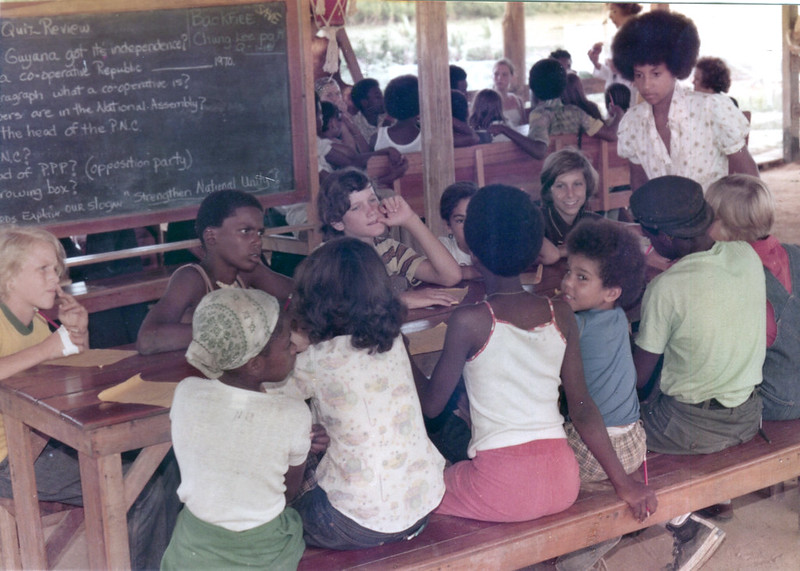 There was practical reasoning to the use of indigenous materials in education in Jonestown. Postcolonial Guyana was suffering from severe poverty and had a shortage of supplies, facilities, lack of capital, and scarcity of trained individuals (Wihak, 2009). It was necessary to use materials native to the local environment because materials made in production factories were not available or affordable. Shortages of school facilities and classroom space required the construction of classrooms and learning areas. This helped generate creative practical learning activities, such as the building of playgrounds and vocational on-the-job training. Shortages of supplies and facilities in the rural area of Guyana in which Jonestown was located were more serious than in urban areas. Distance from urban centers such as Georgetown made travel to acquire materials impractical and cost inefficient. Lack of roads and vehicles limited travel. There was a severe shortage of qualified teachers in the rural areas of Guyana, a problem solved in Jonestown through the use of highly qualified teachers who had been trained in the USA, the use of expert craftspeople to teach vocations, the training of teachers in Jonestown, and community education. Intergenerational learning in the school, community education, and vocational training taught utilitarian and human skills. The use of local talent to teach knowledge native to the local peoples was employed in areas such as agriculture and community education.
There was practical reasoning to the use of indigenous materials in education in Jonestown. Postcolonial Guyana was suffering from severe poverty and had a shortage of supplies, facilities, lack of capital, and scarcity of trained individuals (Wihak, 2009). It was necessary to use materials native to the local environment because materials made in production factories were not available or affordable. Shortages of school facilities and classroom space required the construction of classrooms and learning areas. This helped generate creative practical learning activities, such as the building of playgrounds and vocational on-the-job training. Shortages of supplies and facilities in the rural area of Guyana in which Jonestown was located were more serious than in urban areas. Distance from urban centers such as Georgetown made travel to acquire materials impractical and cost inefficient. Lack of roads and vehicles limited travel. There was a severe shortage of qualified teachers in the rural areas of Guyana, a problem solved in Jonestown through the use of highly qualified teachers who had been trained in the USA, the use of expert craftspeople to teach vocations, the training of teachers in Jonestown, and community education. Intergenerational learning in the school, community education, and vocational training taught utilitarian and human skills. The use of local talent to teach knowledge native to the local peoples was employed in areas such as agriculture and community education.
It was essential for Jonestown to teach people to survive within the local community. Language learning was more than a theoretical exercise. Spanish-English bilingualism was essential for survival and communication with neighboring Spanish-speaking nations. Creative and practical constructive abilities were essential for the development of Jonestown. The sustainability of the communal lifestyle offered in Jonestown depended on learning to use the natural environment and the wisdom of the local communities.
Indigenous Materials in Jonestown Education
A basic premise of Luria’s activity-based learning systems, as employed in the communal education and training systems of Jonestown, was the inclusion of local knowledge through social activities within the group culture (Good, 2000). Luria (1979) found that changes in practical forms of activity, especially activities in formal schooling, produce changes in thought processes. Luria sought to reorganize classroom instruction to include classroom activities (Good, 2000). The inclusion of local Guyanese culture and indigenous materials in classroom instruction in Jonestown included the integration of community learning, curriculum design relevant to daily social life, and the use of indigenous materials in the production of classroom materials. It was found in Jonestown that given the change in cultural environment, and the utilization of activity-based experiential teaching methods, students who had performed poorly in the US schools dramatically improved in the new setting (Jonestown: A Model of Cooperation, 1978).
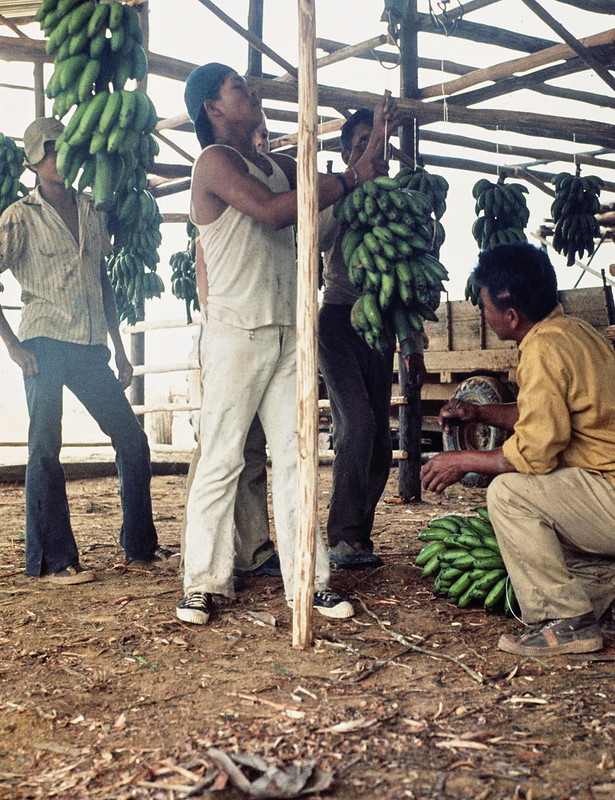 In Jonestown students worked part-time with projects to make education more relevant to life experience (Beck, 2008). The Jonestown practice of activity-based learning was compatible with Luria’s educational theory in that it included the use of indigenous materials, local human expertise, and Guyanese culture in a holistic community classroom without walls.
In Jonestown students worked part-time with projects to make education more relevant to life experience (Beck, 2008). The Jonestown practice of activity-based learning was compatible with Luria’s educational theory in that it included the use of indigenous materials, local human expertise, and Guyanese culture in a holistic community classroom without walls.
The academic and on-the job training that would be needed in Jonestown began previous to arrival in Guyana. Most of the training in Jonestown was done through on-the-job apprenticeships by skilled craftspeople. This included the use of Amerindian and Guyanese experts to teach efficient agricultural techniques in the Guyanese climate (Jonestown Progress Report, 1977). Academic education was taught by highly trained teachers. Community classes were taught by individuals having specific skills.
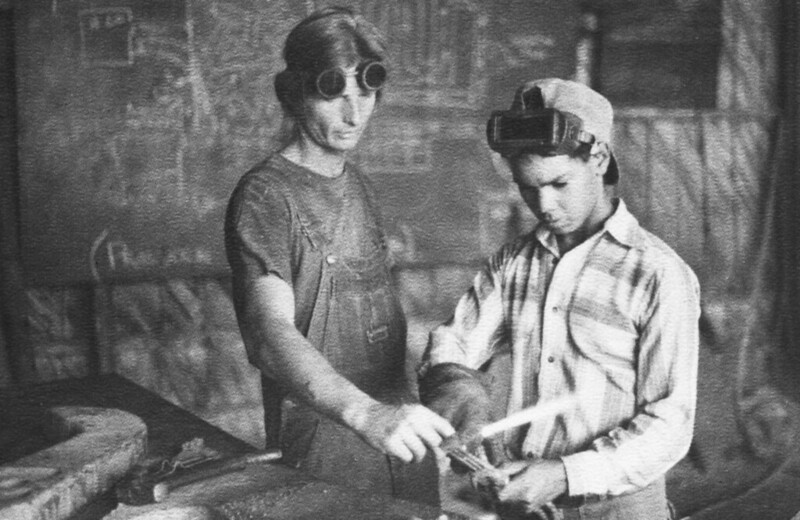 Upon arrival in Guyana, Jonestown residents were trained in over 20 skill sets including agriculture, medical technology, machine and wood shop, mechanics, and crafts (Guyana Chronicle, June 19, 1978). Students in the Jonestown school participated in work-study such as building a playground, engaging in domestic chores, and learning vocational skills (Jonestown Progress Report, 1977). The school grouped students by ability levels, rather than age. Classes included all age groups to teach non-linear human relationship skills. This is a practice which is used in indigenous immersion education, encouraging students to develop through self-motivation, instead of traditional western standardized systems. School curriculum reform to include courses relevant to Guyanese culture was a controversial topic in 1970’s postcolonial Guyana, but in Jonestown, the school curriculum included such subjects as Spanish, Guyanese history, black history, natural sciences, and crafts.
Upon arrival in Guyana, Jonestown residents were trained in over 20 skill sets including agriculture, medical technology, machine and wood shop, mechanics, and crafts (Guyana Chronicle, June 19, 1978). Students in the Jonestown school participated in work-study such as building a playground, engaging in domestic chores, and learning vocational skills (Jonestown Progress Report, 1977). The school grouped students by ability levels, rather than age. Classes included all age groups to teach non-linear human relationship skills. This is a practice which is used in indigenous immersion education, encouraging students to develop through self-motivation, instead of traditional western standardized systems. School curriculum reform to include courses relevant to Guyanese culture was a controversial topic in 1970’s postcolonial Guyana, but in Jonestown, the school curriculum included such subjects as Spanish, Guyanese history, black history, natural sciences, and crafts.
Education materials were made by teachers and students from indigenous materials. This enhanced the development of creative skills and social learning, instead of pre-made supplies which may lead to conformity and repetitive thinking. One example of this given in the Jonestown Progress Report (1977) was the use of steel chalkboards painted with chalkboard paint, so students could use magnets instead of pens and pencils which were in short supply. Most of the materials used in building the Jonestown school, and in building Jonestown itself, came from the local surroundings. Wood would have been milled from local trees, and buildings, furniture, and supplies made from local materials. Thus, the natural habitat had an overwhelming influence on the learning environment.
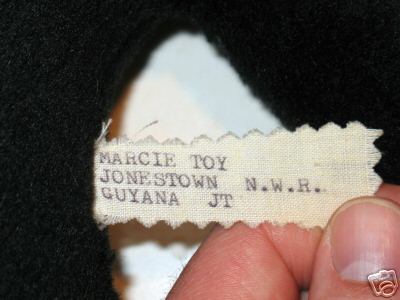 The Jonestown school included arts and crafts, music, language arts, and writing in its curriculum as important attributes to the growth of the child in all aspects of life. Creative activities in Jonestown emphasized group activities that helped develop the life of the community. In addition to the school, evening classes in the creative arts were available to all ages. The artwork created in Jonestown was an expression of the work-based ideals of the agricultural commune. The materials used in these artistic expressions also came from the local environment and had practical applications to the daily life of the commune. Some could be sold in the local community. The items produced included such industrial arts as toy-making, sign-making, stuffed animals, jewelry design, clothing design, textile art, woodworking, metallurgy, candle-making, culinary arts, drawing, and painting.
The Jonestown school included arts and crafts, music, language arts, and writing in its curriculum as important attributes to the growth of the child in all aspects of life. Creative activities in Jonestown emphasized group activities that helped develop the life of the community. In addition to the school, evening classes in the creative arts were available to all ages. The artwork created in Jonestown was an expression of the work-based ideals of the agricultural commune. The materials used in these artistic expressions also came from the local environment and had practical applications to the daily life of the commune. Some could be sold in the local community. The items produced included such industrial arts as toy-making, sign-making, stuffed animals, jewelry design, clothing design, textile art, woodworking, metallurgy, candle-making, culinary arts, drawing, and painting.
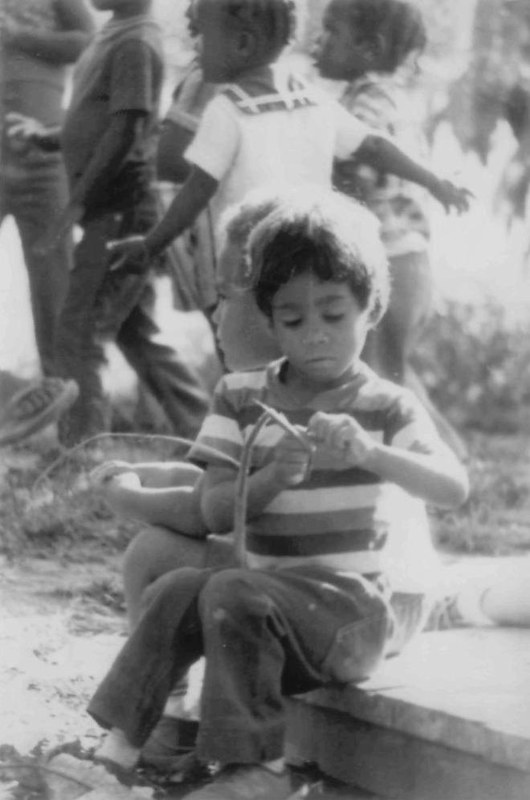 The literature of Jonestown, particularly the writings of children, portrayed the experience of lush colorful vegetation, wildlife, clean air, and the pristine beauty of the Guyanese jungle. The writings of children vividly depicted happiness in a jungle paradise. Personal writings highlighted the healthy diet and abundance of tropical foods available in the natural environment. A personal letter from Marlene Tarver mentioned the benefits of a healthy diet, weight loss, and satisfaction gained from the hard work planting and farming the crops (Cromarty, 2017). Most of the agricultural work was done in community-based social groups. Amerindians and local Guyanese agricultural experts were consulted to learn more efficient methods and increase production. Experimentation was conducted to develop new crops that would be adaptable and useful to the Guyanese soil and climate (Jonestown Progress Report, 1977; Jonestown: A Model of Cooperation, 1978).
The literature of Jonestown, particularly the writings of children, portrayed the experience of lush colorful vegetation, wildlife, clean air, and the pristine beauty of the Guyanese jungle. The writings of children vividly depicted happiness in a jungle paradise. Personal writings highlighted the healthy diet and abundance of tropical foods available in the natural environment. A personal letter from Marlene Tarver mentioned the benefits of a healthy diet, weight loss, and satisfaction gained from the hard work planting and farming the crops (Cromarty, 2017). Most of the agricultural work was done in community-based social groups. Amerindians and local Guyanese agricultural experts were consulted to learn more efficient methods and increase production. Experimentation was conducted to develop new crops that would be adaptable and useful to the Guyanese soil and climate (Jonestown Progress Report, 1977; Jonestown: A Model of Cooperation, 1978).
Adult members were more likely to mention issues of social justice than children, who wrote more of their experience in the natural Guyanese environment. This disparity in the writings of adults and children may represent the different life experience of children in the rural Guyanese environment, and lack of discrimination in the utopian culture of Jonestown, in comparison to the life experiences of adults with the racism of American society.
Inconsistencies
Two aberrations emerged when reviewing the use of indigenous materials in Jonestown. The statement of Dr. Albert Greenfield (A Feeling of Freedom, n.d. 1978), who directed the Medical Network of Amateur Radio Operators comprising more than a thousand physicians, shows one deviation: “It’s mind boggling to see how you have carved out of the jungle a community that looks just like a town in the United States – and with all the public utilities.” Dr. Greenfield continued to compliment the success of the training programs for youth, the medical staff, and the humanitarian efforts of the Peoples Temple.
This statement implies that, although Jonestown was achieving success in key areas of education and medicine in the Guyanese environment, it had not given up its American origins. Jonestown continued receiving at least partial ideological, material, and financial assistance from sources in the US. As such the Jonestown Project was partially dependent on US resources, and never became a fully assimilated Guyanese institution. This may have induced feelings of alienation within the Jonestown community from both American and Guyanese society. The effects of this alienation may have been both beneficial leading to creative learning activities, and detrimental germinating viewpoints and judgements antithetical to humane decision making.
The second item which emerged is that educational ideas and resources from outside the local community may integrate with indigenous knowledge to help a community grow and prosper. New ideas increase the knowledge base and strengthen the community’s ability to survive in a complex world. This encourages views which are compatible with global society and acceptance of human difference.
Conclusion
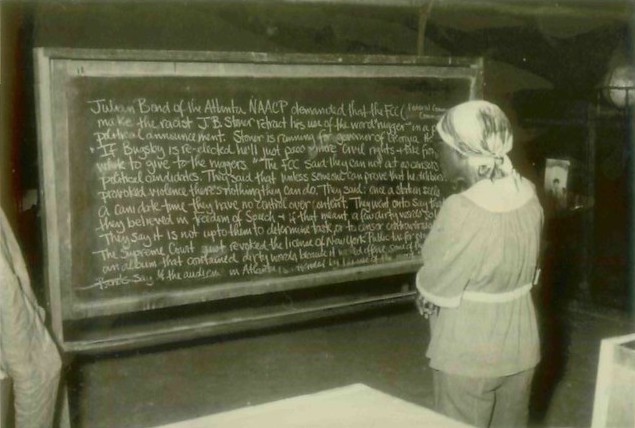 Education in Jonestown was at the cutting edge of progressive educational thought in the 1970’s. The Jonestown School and educational programs, which were accredited by the Guyanese government, achieved a progressive blend of communal, creative activity-based, and indigenous learning. It provided quality education and vocational training by highly skilled teachers and craftspeople within the cooperative socialism of Guyana. The use of indigenous materials, knowledge, and local experts helped students of all ages and backgrounds to become productive successful members of the Jonestown community, and Jonestown as a learning community to become part of the rural Guyanese environment. The use of indigenous educational materials and expertise was driven by more than education theory. It was motivated by practical need, based on the lack of financial and material resources, and the impoverished social and educational conditions inflicted on the peoples of rural Guyana. The beauty of the use of indigenous materials and knowledge in Jonestown, generations before its inclusion into mainstream education, is that it allowed students who had been rejected in American schools to flourish and for the development of a communal society based on racial equality in which all members had a productive role.
Education in Jonestown was at the cutting edge of progressive educational thought in the 1970’s. The Jonestown School and educational programs, which were accredited by the Guyanese government, achieved a progressive blend of communal, creative activity-based, and indigenous learning. It provided quality education and vocational training by highly skilled teachers and craftspeople within the cooperative socialism of Guyana. The use of indigenous materials, knowledge, and local experts helped students of all ages and backgrounds to become productive successful members of the Jonestown community, and Jonestown as a learning community to become part of the rural Guyanese environment. The use of indigenous educational materials and expertise was driven by more than education theory. It was motivated by practical need, based on the lack of financial and material resources, and the impoverished social and educational conditions inflicted on the peoples of rural Guyana. The beauty of the use of indigenous materials and knowledge in Jonestown, generations before its inclusion into mainstream education, is that it allowed students who had been rejected in American schools to flourish and for the development of a communal society based on racial equality in which all members had a productive role.
References
A Feeling of Freedom: A Collection of Photographs & Comments about the Community of Jonestown (n.d., 1978). Peoples Temple Agricultural Project. Accessed 7 June 2020.
Anderson, D. (1980). For the Learning of Mathematics. Short Communication Presented at the Fourth International Congress on Mathematics Education, August, California: FLM Public Association.
Beck, D. (2008). IV. Education, Housing, and Population. Modified 20 October 2013. Accessed July and August 2018.
Brissett, N. (2018). Education for social transformation (EST) in the Caribbean: A postcolonial perspective. Education Sciences, 8(197).
Cromarty, E. (2017). Divergence in the writings of Jonestown. Accessed 1 June 2020.
Good, S. R. (2000). A. R. Luria: A humanistic legacy. Journal of Humanistic Psychology, 40(17), 17-32.
Hennessy, L. (2012). Re-placing indigenous territory: Villagization and the transformation of Amerindian environments under “Cooperative Socialism” in Guyana. People, Place, and Region, 1242-1265. https://doi.org/10.1080/00045608.2012.740382
Ishmael, O. (2012). The transition of Guyanese education in the twentieth century. Georgetown, Guyana: GNI (Guyana News and Information) Publications.
Jonestown: A Model of Cooperation (1978). Peoples Temple Agricultural Project. Accessed 30 November 2017.
Luria, A. R. (1979). The making of mind: A personal account of Soviet psychology (M. Cole & S. Cole. Eds. and Trans.) Cambridge, MA: Harvard University Press.
Mogari, D. (2000). Problems associated with the use of ethnomathematics approach. In: S. Mahlomaholo, M Nkoane, K Smit-(Eds.): Proceedings of the 8th Annual Conference of the Southern African Association for Research in Mathematics and Science Education. South Africa: University of Port Elizabeth.
Peoples Temple Gets Official Status. (19 June 1978). Guyana Chronicle. Accessed 30 November 2017.
Piaget, J. (1966). Psychology of Intelligence. Totowa, New Jersey: Littlefield, Adams and Co., 119-155.
Progress Report-Summer 1977 (1977). Peoples Temple Agricultural Project. Accessed 30 November 2017.
Wihak, C. (2009). Indigenous education for cultural survival: The Makushi amerindians of Guyana. Canadian International Education, 38 (1), 17-28.
